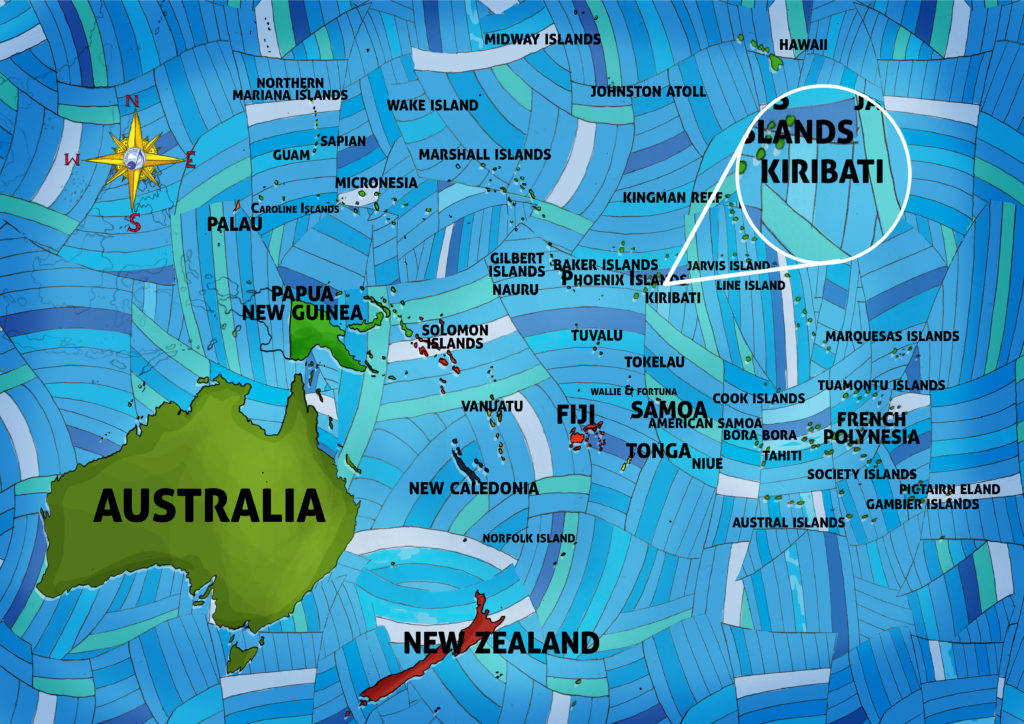We’re on a roll now…so let’s visit one more island nation in Micronesia — the Marshall Islands. Until World War II the Marshall Islands followed much the same historical path as the other island nations in Micronesia; first there were people who spent a thousand or so years developing their own clan-based culture, then there was Spanish exploration, then German colonization resulting in the islands becoming part of German New Guinea, then, in 1914, absorption into the Japanese empire. The Japanese settled the Marshall Islands heavily and replaced local paramount chiefs, who had ruled the Marshall Islands for centuries, with Japanese-appointed leaders. During World War II the United States bombed the Marshall Islands extensively and then invaded in 1944. The battles were harsh and many Marshallese, Japanese, Koreans, and Americans perished there. After taking the Marshall Islands the U.S. used the nation as a staging base for more Pacific campaigns. In 1979 the Marshall Islands became independent since then the nation has signed a Compact of Free Association with the United States. The compact assures the Marshall Islands of U.S. military defense while also allowing the U.S. to maintain a missile testing facility on Kwajalein Atoll.
Tag Archives | Micronesia
Sing It, Sster Lubei!
Yesterday we met Palau, an amazing archipelago in Micronesia. We started in on Palauan history and got sidetracked by Prince Lee Boo. Let’s pick up in 1898 when the Spanish colonizers of Palau lost the Spanish-American War and sold Palau, as part of the larger Caroline Islands, to Germany. Germans “developed” Palau by mining and harvesting its natural resources like bauxite and phosphate. The Japanese made a secret treaty with the British that as part of their declaration of war on Germany they would be given control of Micronesia. In 1914 the Japanese colonized Palau aggressively, and in 1919 the Treaty of Versailles sealed the deal. The Japanese sent many immigrants to populate the islands–at one point the immigrants even outnumbered the indigenous people–and installed Japanese-friendly Palauans into the local leadership. They also confiscated and redistributed lands and supported the development of a patrilineal system of descent. After the Japanese lost World War II Palau became part of U.S.-administered territory and, after a long series of votes and much unrest it officially signed a “Compact of Free Association” with the United States. Got it? Maybe not. But even if you don’t you can get a kick out of Palauan-Hawaiian musician Sister Lubei performing live.
Micronesia: Small Islands With Boundless Beauty

This week in our online classes we leave Melanesia for the many tiny yet infinitely beautiful islands of Micronesia. Let’s start in Kiribati, formerly known as the Gilbert Islands, a group of 32 very close-to-sea-level atolls and one island (Banaba) sprinkled along the very hot equator and stretching from the easternmost point of the eastern hemisphere across the International Date Line and into the western hemisphere. Kiribati, pronounced “Kiribas,” was populated some time about 3000 B.C. and maintained continuous contact with Polynesian islands like Tonga, Samoa and Fiji. Unlike other Micronesian islands it was not part of the Spanish or German colonial sphere, but instead the British settled starting in 1837; the Gilberts became a British protectorate in 1892. The Japanese occupied the Gilberts during World War II and the Americans fought a bloody battle to get them back. After the War the U.S. used some of the Gilbert islands as test sites for nuclear weapons but in 1979 allowed i-Kiribati (the people of Kiribati) to become independent. Kiribati became a member of the United Nations in 1999.

